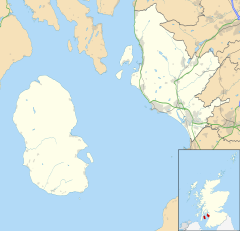Stevenston
Stevenston
|
|
|---|---|
| Stevenston shown within North Ayrshire | |
| Population |
9,129 (2001 census) |
| OS grid reference | NS265425 |
| Council area | |
| Lieutenancy area | |
| Country | Scotland |
| Sovereign state | United Kingdom |
| Post town | STEVENSTON |
| Postcode district | KA20 |
| Dialling code | 01294 |
| Police | Scottish |
| Fire | Scottish |
| Ambulance | Scottish |
| EU Parliament | Scotland |
| UK Parliament | |
| Scottish Parliament | |
9,129 (2001 census)
Stevenston (Scots: Steenstoun, Scottish Gaelic: Baile Steaphain [ˈpaləˈʃtʰʲɛfən]) is a town and parish in North Ayrshire, Scotland. It is one of the "Three Towns" along with Ardrossan and Saltcoats, on the east coast of the Firth of Clyde.
The town is named after Stephan Loccard or Lockhart, whose father obtained a grant of land from Richard de Morville, Lord of Cunninghame and Constable of Scotland, around 1170. The town is first mentioned in a charter of c. 1240.
The Castle Hill near Hullerhirst may have once been the site of a small stone tower. Under a sand mound near Dubbs a stone pavement, coffin, and large boulder were discovered in 1832. Numerous flints tools have been found in the sands of Ardeer.
The town's main link with Robert Burns is that Mayville House was the birthplace in 1768 of Miss Lesley Baillie. Robert Burns met her in 1792 and described her to a friend as "the most beautiful, most elegant woman in the world". She inspired one or two of his love poems, in which she is described as 'Bonnie Lesley'. A memorial now stands in her memory and is situated between Sinclair Street and Glencairn Street.
To the north of the town sits the ruin of Kerelaw Castle, with a history spanning over 800 years. Nearby was Kerelaw House, once home to the family of Alexander Hamilton and later the family of Kenneth Campbell VC RAFVR; however, the house was demolished in the early 1970s.
...
Wikipedia

